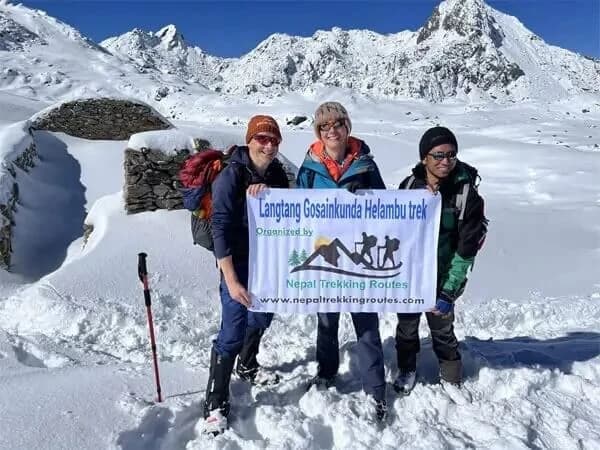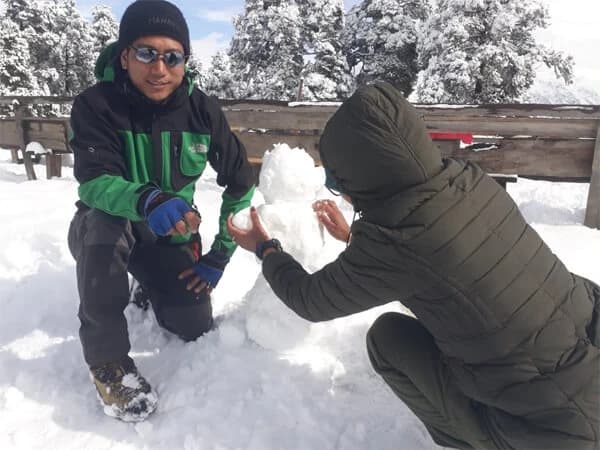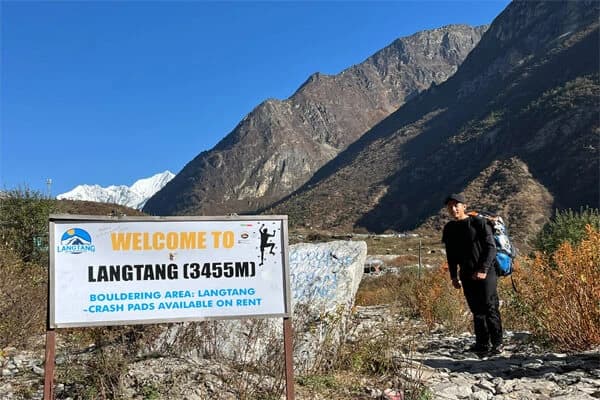A lot of people want to know the Langtang Valley Trek costbefore making travel plans. The Langtang Valley is a fantastic option if you're considering trekking in Nepal but don't want to break the bank. It is less expensive than many other Nepalese treks, picturesque, and near Kathmandu.
The purpose of this blog is to give you an idea of how much money you would need for this trek. Permits, transportation, meals, lodging, and whether you wish to employ a guide or porter are some of the topics we will discuss. We'll also share some clever ways to cut costs without sacrificing enjoyment.
For those who enjoy mountains and peaceful paths, the Langtang Valley Trek is ideal. You will see large snow-capped peaks, stroll through forests, and pass through tiny villages. The majority of trekkers complete the short journey in seven to ten days. You will understand how much to budget, what items may cost more, and how to maximize your financial resources by the end of this blog.
Langtang Valley Trek Overview
The Langtang Valley Trek is a brief yet stunning trek across Nepal's Himalayas. The capital city of Kathmandu is not far away. This walk is popular because it is serene, manageable, and offers breathtaking vistas.
The average person completes the trek in 7–10 days. It begins in the small town of Syabrubesi, which is about 7 to 8 hours away from Kathmandu by bus or jeep. After that, the journey gradually climbs through open valleys, rivers, villages, and forests.
Kyanjin Gompa is the last village on the journey. It's a beautiful location surrounded by snow-capped mountains. You can spend a night or two there. You can also trek to Tserko Ri, a hill, from Kyanjin Gompa. It's high and offers a fantastic view of numerous large mountains.
You will pass by communities like Mundu, Langtang Village, and Lama Hotel on your journey. Teahouses are tiny guesthouses where you will spend the night. These are straightforward but coher you go on the walk, the more expensive food and refreshments become. You will save money on your trek if you pack some dry snacks from Kathmandu, such as energy bars or nuts. Keep a filtered water bottle with you as well. By doing this, you can avoid purchasing pricey and wasteful bottled water.
Go With a Group
You can save money by going on a small tour or trekking with a group. Everyone benefits when the expense of accommodation, porters, and guides is split. Group discounts are also available from our company.
Rent Gear Instead of Buying
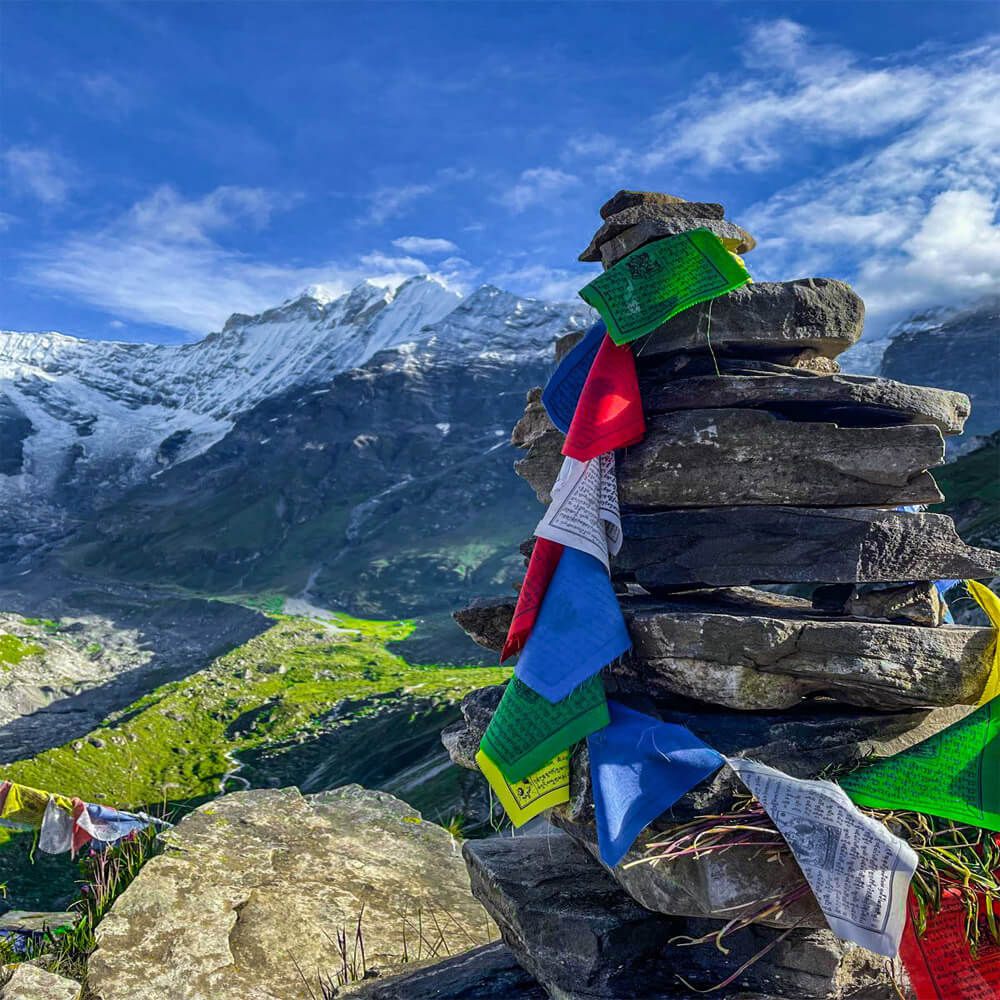
In Kathmandu, you may rent trekking sticks, sleeping bags, and coats rather than purchasing them. It's far less expensive to rent, plus you don't have to carry the equipment home. If you prepare ahead and make straightforward decisions, it's possible to save money on the Langtang Valley Trek!mfortable dining and sleeping areas.
Around 4,984 meters is the highest point that most trekkers reach (Tserko Ri). Walking slowly, however, gives your body time to become used to the height. You can prevent mountain sickness by doing this. For beginners and those with limited time, the Langtang Valley Trek is an excellent option. Despite its little length, it captures the true splendor of the Himalayas, with its towering mountains, gentle people, and peaceful trails. Therefore, the Langtang Valley Trek is a fantastic option if you wish to trek in mountains and experience nature up close!
Factors Affecting the Langtang Valley Trek Price
Langtang Trek Permit Costs
Two important permit are required for trekking in Langtang Valley. Similar to tickets that let you enter a national park, these aid in the government's ability to monitor trekkers. Both permits are required before you can begin the trek.
The TIMS Card
The TIMS Card is the initial permit. Trekkers' Information Management System is referred to as TIMS. Your name, passport number, and trekking itinerary are all on this card. In the event of an emergency, it helps authorities know your location. It also contributes to everyone's safety whentrekking in Nepal. A TIMS Card is available from your trekking agency or the Nepal Tourism Board office in Kathmandu. If you are trekking with a guide, the cost of the TIMS Card is approximately 2,000 Nepali Rupees. It may be more expensive if you are trekking alone. However, trekking by itself is not advised in the Langtang area.
Langtang National Park Entry Permit
The Langtang National Park Entry permission is the second permission you require. There is a national park in the Langtang region. It is home to lofty mountains, untamed wildlife, and lovely woods. The permission funds assist in maintaining the park's cleanliness and safety, and the park itself is protected. This permit costs roughly 3,000 Nepali Rupees. This permit is also available in Kathmandu, at the Dhunche or Syabrubesi park entry, or both.
Langtang Trek Expenses on Transportation
Part of the adventure is traveling to the Langtang Valley. About 122 kilometers from Kathmandu, the little hamlet of Syabrubesi is where the trip begins. Despite the seemingly short distance, the road is twisty and bumpy. So, the journey can take 7 to 9 hours, depending on how you go.
Local buses for Langtang budget Trek
Local buses are the most affordable way to get to Syabrubesi. These buses depart from Kathmandu's Machhapokhari Bus Park early in the morning. Typically, a bus ticket costs between 1000 and 1200 Nepali rupees, or 8 to 10 US dollars. The bus can occasionally get crowded, especially during festivals or holidays, and the journey is rough. However, a lot of people find it to be an enjoyable way to travel like the locals.
Jeep Ride for More Comfort
You can reserve a private or shared jeep for a more comfortable and quick ride. Although a private jeep is more costly, it is quicker and less bumpy. The cost of renting a private jeep can range from $250 to $300 USD one trip. It is less expensive to share the jeep with other trekkers. The average cost of a shared jeep ride is between $25 and $30 USD per person. If you're pressed for time or dislike packed buses, Jeeps are a wonderful option.
Return Trip
You will have to travel back to Kathmandu from Syabrubesi at the end of the trek. Your return bus or jeep can be reserved in advance. To recover before the tough journey back, some trekkers decide to spend an additional night at Syabrubesi. It's a good idea to save some additional cash for transportation in case costs go up or the state of the roads deteriorates. The Langtang trek doesn't have very expensive transportation, but the one you choose will depend on your schedule, comfort level, and budget.
Langtang Trek Food and Lodging Costs
You are not required to bring a tent on the Langtang Valley Trek. There are tiny lodges known as teahouses along the route. Local families operate these basic guesthouses. They provide you with food and a place to sleep. This facilitates and improves the comfort of the trek.
Langtang Trekking Accommodation Cost
The majority of teahouses are tiny spaces with two beds. While most have shared bathrooms, some have attached bathrooms. The rooms are quite simple. Typically, there is a blanket, a bed, and possibly a small table. For added warmth, you might need to pack your own sleeping bag.
Rooms are less expensive throughout the trail's lower sections. Typically, they run between $5 and $7 each night. The price may increase to roughly $8 to $10 per night as you go up. If you eat there, some establishments may even give you the room for free.
How Much Food Costs on the Trail
Food is also served at teahouses. The majority of your meals will be consumed there. Dal Bhat is the most popular dish. This consists of rice, veggies, lentil soup, and occasionally pickles. It fills you up and tastes good. What's the best part? Free refills of Dal Bhat are available!
Meals like fried noodles or dal bhat cost roughly $3 to $5 in the lower sections. The cost of food increases as you move more up into the mountains. The same lunch might cost anything from $6 to $8 at high points like Kyanjin Gompa. This is due to the fact that everything must be carried up by either humans or animals.
The higher you go, the more expensive tea, snacks, and bottled water become. For example, a cup of tea may cost $1 at the beginning and $3 in the end. In the hamlet, a bottle of water might cost $0.50, while on the route, it might cost $2.
Having some extra cash on hand for food and hot beverages is a smart idea. Eating healthily keeps you strong and increases your enjoyment of the trek. A huge part of the Langtang experience is the food and teahouses, and it feels great to eat something warm after a long trek!
Langtang Trek Guide and Porter Fees
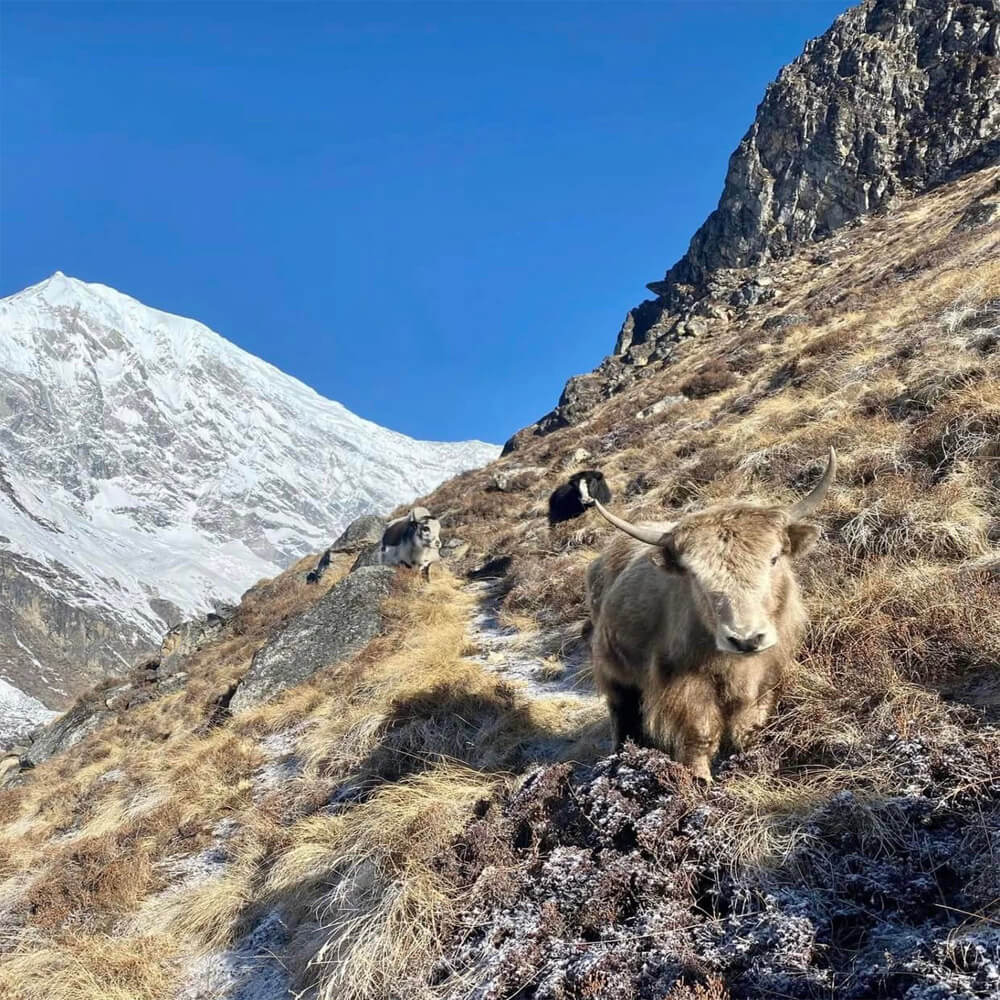
Although the Langtang Valley Trekking is stunning, it can occasionally be difficult to follow, particularly for those who are new to the area. Someone who is well-versed in the way is a guide. They assist you in staying on course, tell you about the local way of life and the mountains, and offer support if you're feeling ill or exhausted. A porter makes it easier for you to walk by carrying your bulky bag.
You are not need to bring a porter or guide. There are those who trek alone. Having assistance, however, might make the walk safer and more enjoyable if you lack experience.
Cost of Hiring a Trekking Guide
For the Langtang Valley Trekking, a professional guide typically charges $25 to $35 per day. Their food, lodging, and insurance are all included in the cost. Most guides are fluent in English and have extensive local knowledge. Some are even somewhat fluent in German, French, or Japanese. Your guide will take care of everything if you reserve your guide through a trekking agency. You won't have to stress over trying to locate someone you can trust in this method. Agency guides are licensed and qualified.
Cost of Hiring a Trekking Porter
A porter often charges $15 to $25 per day, which is less than that of a guide. A porter can lift between 15 and 20 kg. If your bags aren't too heavy, you can split a porter between two trekkers. Porters are accustomed to walking in the highlands and are highly strong. However, packing light is still a smart idea to keep the porter from becoming overly exhausted.
Tipping Your Guide and Porter
Tipping your guide and porter at the end of the trek is considered courteous. This is how you express gratitude. Many trekkers tips around 10% of the total cost of their trek. However, if you are satisfied with their service, you can contribute extra.
It's a good idea to hire a guide or porter if you want to enjoy the walk without having to worry about instructions or carrying a large luggage. Additionally, it helps locals profit from tourism.
Cost of Langtang Valley Hiking Gear
Having the appropriate equipment is crucial while planning your trek in Langtang Valley. In the highlands, the weather is subject to sudden changes. While some days may be sunny and warm, others may have extremely cold nights. To be comfortable and safe on the trail, you must pack carefully. Everything doesn't have to be brand-new. To save money, a lot of trekkers actually rent or borrow equipment.
Buying vs Renting in Kathmandu
You'll probably stay in Kathmandu for a day or two before starting the trek. You can get your trekking equipment here. Numerous stores in Thamel, a bustling area of the city, sell or rent trekking gear. Sleeping bags, trekking boots, gloves, coats, and trekking poles are all available here. Equipment rental is less expensive than purchase. For instance, renting a sleeping bag could run you between $1 and $2 per day. Additionally, poles and jackets cost around the same each day. It might be wiser to purchase your own equipment if you intend to trek again in the future. However, renting is a wise option if it's only for a single visit.
Essentials for Affordable Langtang Valley Trek
A few essentials are needed for the Langtang Valley Trek. Due to the possibility of rocky and uneven routes, quality trekking footwear are essential. Additionally, you will need warm clothing, such as thermal layers and a down jacket, particularly for the chilly mornings and evenings. In the event of rain, a rain jacket is helpful. Sunscreen, sunglasses, a water bottle, and a bag are all useful. You do not need a tent or cooking equipment if you are staying in a teahouse. Because the teahouse blankets aren't always warm enough, most people bring a sleeping bag. Your trek will be more enjoyable, secure, and comfortable if you have the proper equipment. You can get what you need without going over budget if you plan ahead and stick to your budget.
Langtang Valley tour price for Miscellaneous Items
There are a few minor expenses that might mount up while walking in the Langtang Valley. These are nonetheless crucial to be aware of even though they are not as significant as transportation or guide expenses. To help you plan more effectively, let's examine a few of them.
Charging and Internet
In the Langtang Valley, a large number of teahouses are powered by solar energy or small power sources. They frequently charge trekkers to utilize this energy because they use it sparingly. You will have to pay to charge your phone or camera if the battery runs low. The price often ranges from 100 to 300 Nepali rupees, depending on the area. Because electricity is more difficult to obtain higher up in the mountains, prices may be higher.
Some teahouses also provide internet access. Although it isn't always quick or powerful, it is useful for checking the weather or sending messages to family. Wi-Fi is usually available for a fee. For one day of use, this may cost between 200 and 500 Nepali rupees. But keep in mind that the signal isn't always accurate. Maps and other essentials should be downloaded before you begin your trek.
Extra Food, Drinks, and Souvenirs
The teahouse serves three main courses, but occasionally you might want additional snacks or beverages. Even a hot cup of coffee, chocolate bars, soft drinks, and bottled water can cost more than they would in Kathmandu. This is because everything has to be carried up the mountain, often by mules or people. For example, a chocolate bar may cost 300 rupees in a high village. A bottle of water may be 150 to 200 rupees.
Some trekkers also like to buy small souvenirs or give small donations to monasteries or local schools. These are optional, but they are nice ways to support the local people. It’s smart to carry a little extra cash for these small things. There are no ATMs in the mountains, so plan ahead while you’re still in Kathmandu.
Langtang Trek Cost Breakdown
Knowing how much money you may need is helpful when planning the Langtang Valley Trek. How you travel and the type of assistance you require will determine the cost. Let's examine three options for the trek: all-inclusive, mid-range, and economical.
Langtang Budget Trek
The Langtang Valley Trek is most affordable this way. You eat simple meals, bring your own bag, and reserve your own teahouses. You get to and from Syabrubesi via local bus. You don't employ porters or guides.
Every day, you will spend between $25 to $35. The overall expense for a 10-day expedition might be between $300 and $400. This covers lodging, transportation, food, and permits. But keep in mind that carrying everything by yourself can be exhausting.
Mid Range Kathamandu to Langtang Trek Cost
You can hire a porter or a guide if you need a little extra assistance. A guide tells you stories and shows you the way. Your bulky bag is carried by a porter. This facilitates and enhances the enjoyment of the walk.
Approximately $45 to $65 will be spent per day. The expense of a 10-day journey is between $500 and $700. Your meals, teahouses, permits, transportation, and the guide or porter fee are all included in this cost. A lot of folks find it to be a good option.
Langtang Trekking Package Cost
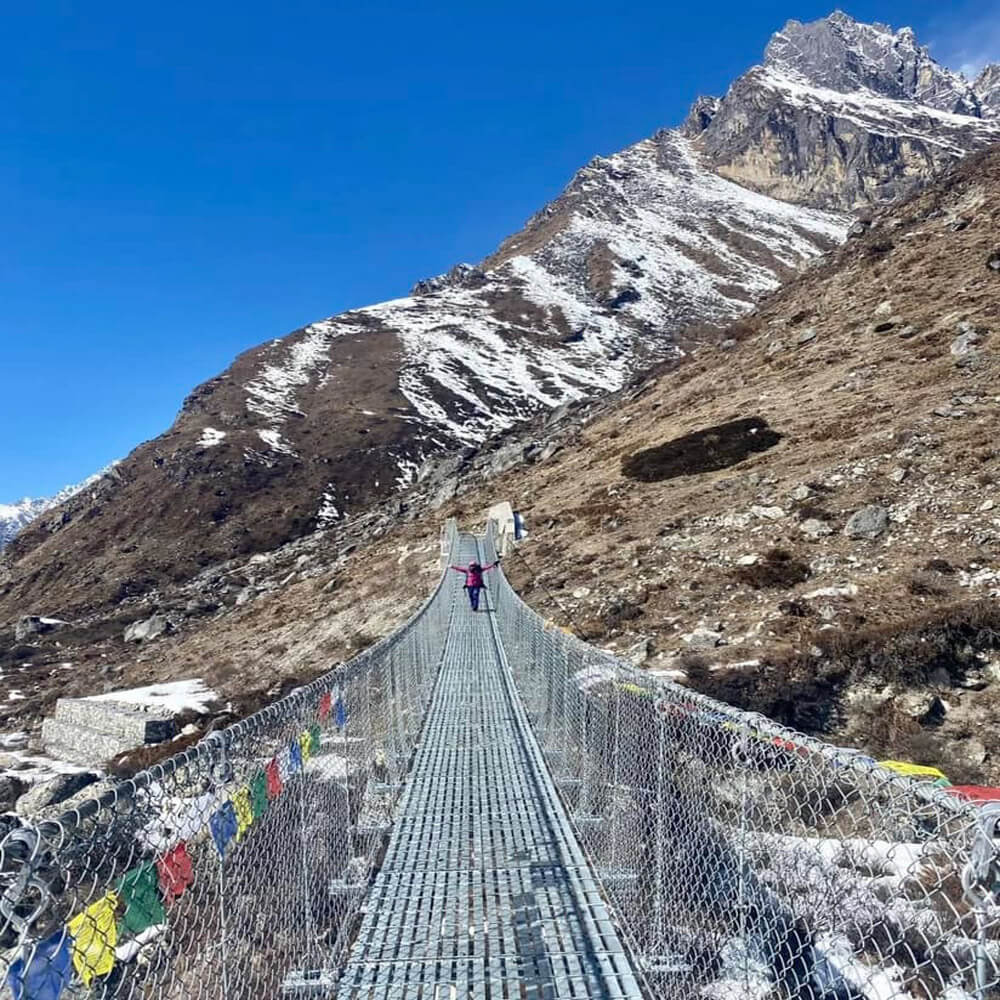
You can reserve an entire Langtang valley trekking package with a trekking agency if you don't want to deal with the planning. Transportation, lodging in Kathmandu, a guide, a porter, food, and trailside accommodations are all handled by them. You simply stroll and have pleasure.
For ten days, the Langtang Trek price for foreigners could be between $800 and $1,200. It's easier and more comfortable, but it costs more. Everything can be arranged for you by our company, Nepal Trekking Routes. Whichever option you decide on, Langtang Valley is a stunning location. You can have fun on the trek without going over budget if you have the proper plan.
How to Save Money Without Sacrificing the Experience
Travel in Langtang Valley in Off-Season
Traveling during the off-season is one of the best ways to save money on the Langtang Valley Trek. This means avoiding the busy months like October and April. Hotel and food costs will be lower if you travel in early spring or late autumn. The walk will feel more tranquil because the trails will be quieter.
Share a Jeep or Bus
It can be costly to travel alone in a private jeep from Kathmandu to Syabrubesi. But the price drops significantly if you travel with other trekkers. Although they are the least expensive, public buses are sluggish and unreliable. If you wish to save money without sacrificing comfort, sharing is a wise decision.
Bring Snacks and a Water Bottle
The higher you go on the walk, the more expensive food and refreshments become. You will save money on your trek if you pack some dry snacks from Kathmandu, such as energy bars or nuts. Keep a filtered water bottle with you as well. By doing this, you can avoid purchasing pricey and wasteful bottled water.
Go With a Group
You can save money by going on a small tour or trekking with a group. Everyone benefits when the expense of accommodation, porters, and guides is split. Group discounts are also available from our company.
Rent Gear Instead of Buying
In Kathmandu, you may rent trekking sticks, sleeping bags, and coats rather than purchasing them. It's far less expensive to rent, plus you don't have to carry the equipment home. If you prepare ahead and make straightforward decisions, it's possible to save money on the Langtang Valley Trek!
Is Langtang Valley Trek Worth the Cost?
This is a question that many people have before organizing a trek. Is the Langtang Valley Trek truly worth the money? Let me give you a basic explanation.
What You Get for the Price
You are paying for more than just walking when you sign up for the Langtang Valley Trek. The entire adventure is being paid for by you. You will view towering snow-capped mountains, cross rivers, and stroll through lovely woodlands. Additionally, you will travel to small towns and encounter friendly mountain dwellers. Local families will prepare your meals and provide you with a cozy place to sleep while you are staying in teahouses. There is nowhere else where you can do this. The experience is unique.
Nature and Peace Together
Compared to other Nepal treks, Langtang is incredibly peaceful. It's not very crowded. This means you can truly experience nature all around you, walk in quiet, and listen to birds. If you're lucky, you might also spot eagles, red pandas, or yaks. You feel cheerful and healthy because of the fresh mountain water and clean air.
A Memory for a Lifetime
You get something that you can't purchase at a store with the money you spend on this adventure. It creates a memory that will last a lifetime. When you arrive to Kyanjin Gompa or go to the summit of Tserko Ri, you will experience a sense of pride and happiness. The Langtang Valley Trek is therefore definitely worth the money. It's not just a journey. Your heart is touched by the journey.
Some of Frequently Asked Question
What is the Langtang Valley Trip total cost?
The usual cost is between $800 to $1000 per person, depending on whether you trek alone or purchase a guided package.
How much do permits cost and what are required?
The TIMS card ($20) and the Langtang National Park entry pass ($30) are required.
Does trekking with or without a guide cost less?
It is less expensive to trek without a guide, but it is safer and more comfortable to hire a guide ($25–30/day) and porter ($20–25/day).
How much does it cost to eat and stay on the trail?
Room rates range from $6 to $10 per night. Set aside $25 to $35 per day for meals, which cost roughly $5 to $8 per dish.
Is it possible to rent trekking equipment in Kathmandu?
Yes! Equipment like sleeping bags and coats can be rented for $1 to $3 per day.
Conclusion: Langtang valley Trek cost
One stunning and reasonably priced trek in Nepal is the Langtang Valley trek. It is not too costly, despite the fact that you must pay for licenses, transportation, meals, and accommodation. Due to its short length, lack of crowds, and abundance of local culture, rivers, and mountain views, this walk is very popular.
You may prevent surprises and save money by making a plan in advance. Selecting the appropriate time of year also lowers the price. For first-timers in particular, the trek is safer and easier when accompanied by a guide or porter.
You may simplify things by booking your trek with us. We provide reasonable costs and are well-versed about the route. Depending on your budget, you can select a personalized plan or a full package. Thus, the Langtang Valley Trek is a fantastic option if you want to trek in the Himalayas without breaking the bank!





